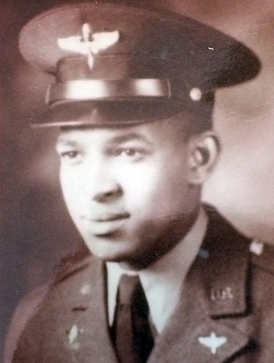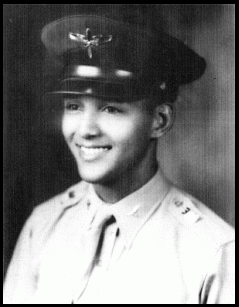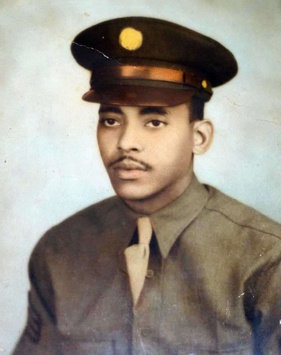The Tuskegee Airmen was a group of African American military pilots and airmen who fought in World War II. They formed the 332nd Fighter Group and the 477th Bombardment Group (Medium) of the United States Army Air Forces (USAAF). The name also applies to the navigators, bombardiers, mechanics, instructors, crew chiefs, nurses, cooks, and other support personnel. The Tuskegee airmen received praise for their excellent combat record earned while protecting American bombers from enemy fighters. The group was awarded three Distinguished Unit Citations.

Alexander Jefferson (POW) (WIA) was an American Air Force officer, famous as one of the Tuskegee Airmen, the 332nd Fighter Group. He served in the United States Army Air Forces during World War II.

Milton Pitts Crenchaw was an American aviator who served with the Tuskegee Airmen during World War II and was the first Arkansan to be trained by the federal government as a civilian licensed pilot. He served during World War II as a civilian flight instructor. He was one of the two original supervising squadron members. In 1998 he was inducted into the Arkansas Aviation Hall of Fame. The grandson of a slave, he was known as the "father of black aviation in Arkansas" who broke through color barriers in the military.

Brigadier General Charles Edward McGee was an American fighter pilot who was one of the first African American aviators in the United States military and one of the last living members of the Tuskegee Airmen. McGee first began his career in World War II flying with the Tuskegee Airmen, an all African American military pilot group at a time of segregation in the armed forces. His military aviation career lasted 30 years in which McGee flew 409 combat missions in World War II, the Korean War and Vietnam War.

Clarence W. Dart, Sr. (WIA) was an American World War II fighter pilot and member of the Tuskegee Airmen. During World War II. Dart was shot down twice earning two purple hearts. He was the recipient of the Distinguished Flying Cross award.
Master Sergeant Buford A. Johnson was a member of the famed group of African-American World War II pilots and support personnel known as the Tuskegee Airmen. During World War II, he served as the chief mechanic servicing the fighter planes of the 99th Fighter Squadron of the 477th Composite Group.

George Hardy is an American retired pilot and military officer. In World War II Hardy served with the Tuskegee Airmen and flew 21 combat missions. In the Korean War he flew 45 combat mission as the pilot of a bomber. In the Vietnam War Hardy flew 70 combat missions piloting an AC-119K gunship.

Robert Jones Friend was an American military officer and pilot who served with the Tuskegee Airmen during World War II and led the USAF's Project Blue Book from 1958 to 1963. He also served during the Korean War and the Vietnam War. He had a 28-year military career.

2nd Lt. Alfred M. Gorham (1920–2009) (POW) was a Tuskegee Airman from Waukesha, Wisconsin. He was the only Tuskegee Airman from Wisconsin, and he was a prisoner of war after his plane went down over Munich, Germany in World War II.

MSgt. Willie Rogers (WIA) was a member of the famed group of World War II-era African-Americans known as the Tuskegee Airmen. He was shot twice in Italy during World War II.

SSG Wilfred DeFour was a Panamanian-American soldier and centenarian. Born in Colón, Panama in 1918, DeFour emigrated with his family to the United States when Wilfred was still a child. The family settled in the Harlem section of New York City.

Flight Officer John Lyle was an American World War II pilot and a member of the famed group of World War II-era African-Americans known as the Tuskegee Airmen. Dickson flew 26 combat missions during WWII. He had a lifelong love of sailing and over the course of his life he owned seven different boats. He was nicknamed Captain Jack for his love of sailing.

Flight Officer William Armstrong † was a member of the famed group of World War II-era African-Americans known as the Tuskegee Airmen. His plane was shot down on Easter Sunday in 1945 over Austria. In 2018 he was inducted into the Rhode Island Aviation Hall of Fame.

James Johnson Kelly was a United States Army Air Force/United States Air Force officer who served with the 99th Fighter Squadron and 332nd Fighter Group. He served in the Korean War at the Battle of Chosin Reservoir, and he retired in 1971 as a Major in the Air Force and a Squadron Commander.

Sgt. Major Thomas Ellis from San Antonio, Texas, was a member of the famed group of World War II-era African-Americans known as the Tuskegee Airmen. He served in the 301st Fighter Squadron and the 332nd Fighter Group during WWII.

James Henry Harvey III is a retired United States Army Air Corps/United States Air Force (USAF) officer and former African American fighter pilot who served with 332nd Fighter Group's 99th Fighter Squadron, best known as the Tuskegee Airmen, "Red Tails", or among enemy German pilots, Schwartze Vogelmenschen. He is one of the 1,007 documented Tuskegee Airmen pilots.

Harold H. Brown was a U.S. Army Air Force officer who served during World War II as a combat fighter pilot with the 332nd Fighter Group, best known as the Tuskegee Airmen. Brown's P-51C aircraft was shot down in the European Theatre of World War II and he became a prisoner of war.
Woodrow Wilson Crockett(pronounced "Crow-Ket") was an officer in the U.S. Army Air Force/U.S. Air Force and a fighter pilot and interim commanding officer of the all-African American 332nd Fighter Group's 100th Fighter Squadron, best known as the Tuskegee Airmen or "Red Tails". He was one of the 1,007 documented Tuskegee Airmen Pilots.
Luke Joseph Weathers, Jr., was a U.S. Army Air Force officer, historic African American air traffic controller and prolific World War II combat fighter pilot with the prodigious 332nd Fighter Group's 302nd Fighter Squadron, best known as the Tuskegee Airmen, "Red Tails," or "Schwartze Vogelmenschen" among enemy German pilots. Weathers earned a Distinguished Flying Cross for defending and escorting a damaged U.S. Army Air Corps B-24 Liberator bomber against eight Messerschmitt Bf 109s on November 16, 1944, shooting down two Bf 109s.

James Alonzo Walker was an American aviator from Manning, South Carolina who served as a Tuskegee Airman during World War II. He flew more than 102 missions in the European Theatre of WWII, and was shot down in action over Serbia at the time occupied Kingdom of Yugoslavia by Third Reich ( Germany). He was saved in Halyard Mission known in Serbian as in July 1944t, by Chetniks and general Dragoljub Draža Mihailović. He served in the military until 1964. He became the first African American commander of an integrated unit in 1950.

















